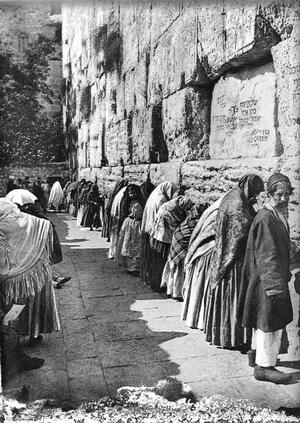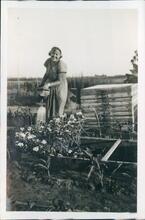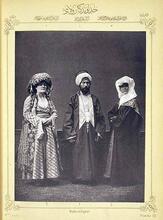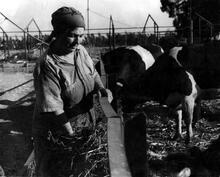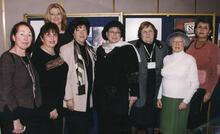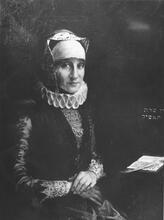Old Yishuv: Palestine at the End of the Ottoman Period
Photographer: American Colony Photo Dept/Matson Photo Service
Institution: U.S. Library of Congress
Jews of the Old Yishuv, who settled in Palestine before 1882, primarily immigrated in the interest of devoting their lives to religion. Women of the Old Yishuv saw their immigration to the Holy Land as serving spiritual sanctification, but they also experienced considerable material suffering. Child marriage was common, as was infant mortality. Apartments in the Old City generally consisted of one room for the whole family, and women’s lives were largely confined to the home. The Old Yishuv also included a large population of widowed Jewish women who immigrated to Palestine in order to live closer to holy places as they approached their deaths.
From 1840 onward (i.e., from the time that the Ottoman Empire regained Palestine from Egyptian rule) the Jewish community of Palestine began to expand at an ever-increasing pace. At the time, approximately ten thousand Jews lived in the country, mainly in the four Holy Cities: Jerusalem, Hebron, Safed, and Tiberias. Newly developing political conditions and modern technologies, coupled with long-standing religious longings and new winds of migration blowing from Europe, were all factors that promoted the renewed and vigorous growth of the Jewish community. In 1914, on the eve of World War I, there were 86,000 Jews in the country. The immigrants came from a variety of regions, including eastern and western Europe, Asia, and North Africa. Both men and women came mainly to fulfill their wish to live in the Holy Land and to devote their lives to religious obligations. They have become known as the people of the Old >Jewish community in Palestine prior to the establishment of the State of Israel. "Old Yishuv" refers to the Jewish community prior to 1882; "New Yishuv" to that following 1882.Yishuv. From 1882 on, some of the newcomers arrived with new nationalistic ideals. They usually settled in new colonies they established or in Jaffa and Haifa, and they were referred to as the New Yishuv.
The Old Yishuv Jews perceived themselves as an elite group representing the entire Jewish population in the Holy Land. Because of the difficulties in making a living in Palestine, the Pre-Zionist era system whereby Diaspora Jews financed the Jewish communities in the holy cities of Erez Israel.halukkah system was created, according to which the entire Jewish world sent financial aid to their co-religionists who lived in the Holy Land, men and women alike. Ashkenazi society, which by the end of the nineteenth century had become the largest Jewish community in Palestine, expected all its male members to spend their time studying Torah. The Jerusalem Ashkenazi community founded a remarkable number of hadarim and yeshivot (religious schools and academies) for their male population, while the Sephardi community suggested that only those males who excelled in their studies should devote their lives to Torah she-bi-khetav: Lit. "the written Torah." The Bible; the Pentateuch; Tanakh (the Pentateuch, Prophets and Hagiographia)Torah studies. As a result, life in the four Holy Cities was characterized by distinct Jewish male characteristics—the study of the Holy Scriptures and public prayer, from both of which Jewish women were traditionally exempt. However, the immigration experience also had a unique female character.
Widows in the Old Yishuv
Censuses of Jews in Palestine at the end of the Ottoman period reveal that the majority of the Jewish population was female. Demographer and statistician Uziel Schmelz summarized the information gleaned from various nineteenth-century censuses: “Forty-nine percent of all Jewish [adult] women [in Jerusalem] in 1839 and thirty-six percent in 1866 were widows. … There was a considerable excess of women over men in the adult population [of Jerusalem].” According to Schmelz’s calculations, based on a 1905 estimate, the number of Jewish women aged sixty and over was twice that of the parallel age group in men. Schmelz attributes this to two factors: a. widowhood, which enabled Jewish women for the first time to decide what to do with their lives, and b. male mortality, owing to the higher age of husbands compared with their wives and women’s longer life expectancy. Towards the end of the nineteenth century there was a decline in the number of widows.
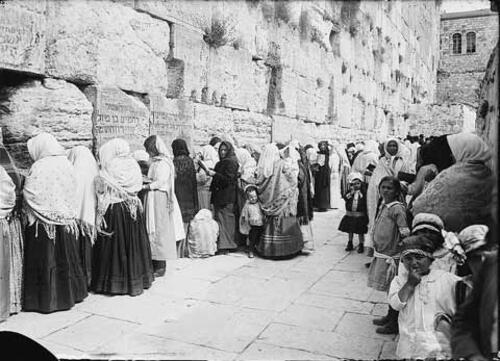
The lifestyle of the women in the Holy Land largely embodied their religious ideals. Not content merely to live in the Land, they spent their time visiting the holy places a kind of pilgrimage within pilgrimage. They would gather regularly for prayer at holy sites, most prominently the Western Wall (as shown in this period photograph) and Rachel's tomb.
Photographer: American Colony Photo Dept/Matson Photo Service
Institution: U.S. Library of Congress
There was a time-honored tradition, common among both men and women, of coming to the Holy Land to die and be interred in its soil. For widows, life in the Holy Land promised a new religious experience, which they could not achieve in the Diaspora. Diverse documents unfold the story of Jewish widows who left their empty homes and grown-up children in order to spend the rest of their lives near the holy places, while praying and waiting “for the good hour,” their approaching death. The noted Glueckel of Hameln wrote in her memoir about her yearnings to go to the Holy Land and live a righteous life there. Glueckel did not realize her dream, but many others, from Europe and from the Ottoman Empire, came to fulfill their deep religious longings. The Land of Israel was not only a place where men achieved their highest religious aspirations, but even more, a place where Jewish women established a cult of women who devoted their time to prayer in the holy places and to living an ongoing pilgrimage.
Wealthier widows received a regular allowance from their families abroad and lived in well-appointed rooms, some even adopting “sons” from the Sephardi community who would care for their needs and ease their solitude; however, most of the women were not rich, and they created a unique female (unisexual) community. They received some support from the Sephardic and Ashkenazic communities. In 1875, the Sephardi community established a hostel for such widows, known as Gevul Almanah (The Widow’s Homestead). It comprised seventeen rooms, each room sometimes housing as many as seven women. Poor Ashkenazi widows were housed in the basement of the Hurvah synagogue. Women of the North African community, who were known for their poverty, lived in the hekdesh (consecrated property) of the community or in a rented room. The latter, like their Sephardic sisters, supported one another. Sephardic folklore describes the relations among the widows as a form of kinship, almost a commune.
The lifestyle of the women in the Holy Land largely embodied their religious ideals. Not content merely to live in the Land, they spent their time visiting the holy places on set dates—a kind of pilgrimage within pilgrimage. On every Rosh Hodesh (the first day of the month in the Jewish calendar) they would gather by the Western Wall or at other holy sites to hear prayers that included a description of the Day of Judgment.
Nowhere did the female desire for identification with deceased saints, whose burial places became attractions for visitors, find more profound expression than at the tomb of the Matriarch Rachel. Rachel’s Tomb in Bethlehem, on the road to Hebron, some two hours’ walk from the Old City, attracted frequent visitors, particularly on the first day of every Hebrew month. Other dates included the month of Elul, during the Ten Days of Penitence, and on the eleventh of Heshvan, the supposed day of Rachel’s death. Visitors would pray for themselves and for the benefactors whose donations provided them with sustenance.
One piece of evidence, though difficult to substantiate, concerning the development of the female cult at the tomb of Rachel, reads as follows:
Every New Moon the Maid of Ludmir would lead her admirers to Rachel's Tomb and hold a solemn prayer service, with impressive ceremony. At the Tomb of the Matriarch Rachel the Maiden would offer all the prayers and supplications that had accumulated over the past four weeks, in response to all those who had come to her for help.
The famed female zaddik, the Maid of Ludmir, Hannah Rachel Werbermacher (1805–1892), who came to The Land of IsraelErez Israel in the second half of the nineteenth century, was one of the more remarkable immigrants. As far as we know, she had elected since her youth to live a celibate life and devote herself to the love of God. Married once and almost immediately divorced, she was a controversial figure. On the one hand, her immigration was convenient for her community of origin, which took exception to her behavior; on the other, it enabled her to express her religious experience in the manner she desired, since “there in the Holy Land she would be able to worship God in her own way.”
Old Jewish women were not the only ones who came alone to the Holy Land. Thousands of elderly Christian women, Russians and other nationalities, traveled to the country in the second half of the nineteenth century. Pilgrimage to the Holy Land provided these women, who were mostly abysmally poor and ignorant, with the most important religious experience of their lives. However, in contrast to Christian women, who came as pilgrims for a limited time, the Jewish widows (who came alone, as individuals) settled in the country, intending to be buried there when their time came. For them, immigration was a journey which would end in the World to Come.
Women's Life as Sacrifice & Sanctification
The Four Holy Cities welcomed not only elderly widows but also many young families, husbands and wives who yearned for children and who believed that their stay in the Holy Land would help them achieve their wish. Others, who came with young children, came to the country in order to escape from the new winds of the enlightenment and to raise their little ones in the holy atmosphere. These and others who had come to live in the country experienced both the heavy burden of separation from their extended families and the burden of coming to a poor society and to very poor living conditions. Paradoxically, what was ostensibly the Jewish homeland instilled a sensation of exile in those whose immigration cut them off from their families. The family home, which was also the central religious space of the Jewish woman, was replaced by the national home—the Holy Land.
Evidence written by women of life in the country described it as an ongoing sacrifice to God. Rivkah Lipa Anikster (d. Jerusalem 1893), who immigrated with her husband in 1862, indeed compared her immigration to Erez Israel to a sacrifice—no ordinary sacrifice, but one comparable to Abraham’s offering of Isaac on the altar. In a pamphlet entitled Sefer Zekher Olam (For Eternal Memory), which she wrote in Yiddish and first published in 1882 in Jerusalem, she wrote about her sense of sacrifice: “You should know, my beloved children, that our journey to the Holy City of Jerusalem was very difficult, it was a test like the binding of the Patriarch Isaac.” Rivkah Lipa, who lost seven infant children in her native town, was addressing the children who remained there while she and her husband immigrated to Jerusalem. She had left them behind in the conviction that her good deed, immigration to the Holy Land, would grant them long life. She most probably did not take them along with her because of the high child mortality rate in Jerusalem. She tried to explain to them how she had suffered since abandoning them. The story of the sacrifice of Isaac was thus being viewed in a feminized version, though it is not clear whether the “sacrifice” bound on the altar was herself, distraught over leaving her children, or the abandoned children themselves.
The death of young children in the Holy Land, resulting from poor sanitary and health conditions, hit hardest the women who were traditionally the caretakers of both young and old. These and other arduous conditions led some women to refuse to join their husbands in their immigration. These refusals raised weighty The legal corpus of Jewish laws and observances as prescribed in the Torah and interpreted by rabbinic authorities, beginning with those of the Mishnah and Talmud.halakhic questions, which throw light on the attitude of the rabbinical establishment both towards women and towards immigration. Halakhic tradition considers the love of Erez Israel to take precedence over love for one’s spouse. Accordingly, a man is entitled to divorce his wife without paying her due from the Marriage document (in Aramaic) dictating husband's personal and financial obligations to his wife.ketubbah or to marry a second wife if the first refuses to immigrate to the Holy Land with him. Judging from rabbinical Halakhic decisions written by rabbinic authories in response to questions posed to them.responsa written in the nineteenth century, rabbis differed as to whether a husband could compel his wife to accompany him to Erez Israel. R. Solomon Kluger (1785–1869), one of the most prominent halakhic authorities of the time, ruled that “if a person married a woman, it is his duty to live with her wherever she lives,” implying that, since it was not the common practice for men to immigrate, it was not justified to force a woman to do so. Throughout the generations rabbis wavered between religious commitment to immigration, on the one hand, and pragmatic considerations such as contemporary conditions and the psychological effect of immigration on the family, on the other. It would appear that since most of the rabbis to whom such questions were addressed did not come to the Holy Land, they did not consider immigration as an immediate religious imperative. Their refusal to make divorce mandatory in such cases may attest more to an ambiguous attitude to immigration than to consideration of the needs of women who refused to immigrate.
Syla and Eliezer Bergman, who were the first to come as a family unit from Germany in 1834 and whose letters from Jerusalem were published in a book entitled Yisu Harim Shalom, described their experiences candidly. Syla, whose possessions were lost in a storm off the coast of Jaffa, wrote: “I have now lost everything that I possessed. I console myself … with the thought that I am in Jerusalem. For that is a great privilege . . . Nevertheless, I would not advise anyone not strong enough to attempt this: one must suffer a great deal.” This, in a nutshell, conveys the feminine experience in Jerusalem: a sensation of unavoidable suffering, to be endured as a sacrifice to God. Indeed, the word “sacrifice” recurs again and again in women’s immigration narratives.
Another motif that is repeated mainly by women refers to their attachment to the ancient history of the Holy Land. When Sir Moses Montefiore (1784–1885) made his sixth visit to Palestine in 1866, he met a young widow aged about twenty, with three infant children. Montefiore was asked by well-wishers to help her by providing her with money to leave the country so that she could live close to her family in Germany. However, the widow, whose name is not known, refused to accept his help, explaining her position as follows:
God has granted me the high privilege to breathe the hallowed atmosphere of the land of our forefathers, Abraham, Isaac and Jacob. He has caused His grace and mercy to descend upon me by bringing me, when an infant, unto this sacred spot. … He has permitted me to tread on that hallowed ground on which our prophets and our teachers lived. … Am I now to leave it and take my children away from Zion? ... No; I would rather starve together with my children, whilst kissing the dust in the Holy City Jerusalem, than live in plenty elsewhere.
The young widow’s statement expresses profound identification with the historical past of the Jewish people, which was so palpably present everywhere in Erez Israel.
Writing of her first trip to Palestine in 1827, Judith Montefiore (1784–1862), the wife of Sir Moses, described the history of Jerusalem at length, dwelling on the different historical periods—from David and Solomon to the Ottoman Empire. The visit, she writes, was inspiring: “We are standing in the place where great events took place … and we feel a profound sense of worship.” Upon visiting the Temple Mount, she wrote of her feeling “as if the building was still before us.” Such veneration of the past was infused with hopes for its restoration, and she ends her diary with one of Isaiah’s prophecies of consolation (Isa. 35:10). During her second visit, in 1839, her visit to the Western Wall of the Temple Mount aroused in her intense yearning for redemption, signifying her belief that all hope was not lost. “The day will surely come,” she wrote in her diary, “that all the nations will come to worship the God of Israel.”
Immigration to Erez Israel was the most important rite-of-passage in the immigrant’s life, giving women among the newcomers an opportunity to shape new lives for themselves. For some women immigration was a traumatic experience, involving coercion and self-sacrifice; others saw it as offering new prospects and challenges. In contrast to the canonical nature of masculine Judaism, shaped by the intellectual world of [jwa_encyclopedia_glossary:320]halakhah[jwa_encyclopedia_glossary], women’s spiritual world was shaped by a variety of practical aspects. Excluded from the centers of power and ritual of the religious establishment, women were inspired to find alternative channels of activity: immigration on their own, development of their own rituals at holy places and even formation of a specifically female holy place—Rachel’s Tomb. Thus immigration to the Holy Land meant combining spiritual elation and sanctification, on the one hand, with suffering and distress on the other.
Marriage in the Old Yishuv
The Jewish community of Jerusalem, which conceived of itself as the holiest among Jewish communities worldwide, formulated special regulations in order to ensure the sanctity of families in general and women in particular. The community’s involvement in the life of the individual was total. The unique character of the community was achieved by means of special regulations supplementing the law of the Torah she-bi-khetav: Lit. "the written Torah." The Bible; the Pentateuch; Tanakh (the Pentateuch, Prophets and Hagiographia)Torah (Heb. Regulation supplementing the laws of the Torah enacted by a halakhic authority.takkanot) enacted in the Holy City, known as the “Jerusalem Regulations.” Developed over several centuries, these regulations, first published in print in Jerusalem in 1842, enjoyed The legal corpus of Jewish laws and observances as prescribed in the Torah and interpreted by rabbinic authorities, beginning with those of the Mishnah and Talmud.halakhic authority and reemphasized the status of Jerusalem as the Holy City.
An instructive example is the so-called “Bachelors Regulation,” which dealt with family life in the community. It decreed that the right of any Jewish male aged from twenty to sixty to live in the Holy City was conditional on his family status:
As to the matter of bachelors aged twenty years and more, they shall not be allowed to live in the Holy City of Jerusalem, may it be rebuilt and reconstructed, without a wife. … And if he is unable to do so because he has found no time to wed a wife, he must depart forthwith from this Holy City and seek his life abroad. The community … is entitled, in regard to whosoever should transgress these instructions of ours, to banish him from the land.
The object of the regulation was to safeguard the moral fiber of the community. It was aimed at bachelors who came to live in Jerusalem and attributed their unmarried state to lack of means. The regulation granted them four (or six) months to find a spouse; otherwise, they had to leave the city. In Jerusalem marriage was not only a personal religious obligation but also a public duty. Married life was recognized as the best way to preserve the purity of the society. The lack of any reference to women in the regulation speaks for itself; it essentially expresses the view that women are no more than instruments, expected to come and get married at any time and under any conditions. There was no similar regulation concerning women—that would have been considered superfluous or impractical. The various censuses show that nearly one hundred percent of the adult Jewish male population was married at an early age.
According to Jewish law, the minimal age for marriage is thirteen years for a boy and twelve for a girl (Shulhan Arukh, Hilkhot Piryah u-Reviyah 1:3). Marriage at an early age was the norm in most traditional societies—it was one way in which society ensured that the young of the community would be dependent on their elders. This was standard in East European Jewry, in Yemen, and in the Mediterranean countries, where it was customary to marry at an even younger age than decreed by The legal corpus of Jewish laws and observances as prescribed in the Torah and interpreted by rabbinic authorities, beginning with those of the Mishnah and Talmud.halakhah. This usage was justified by a variety of reasons: the hardships of life in exile, the desire to guarantee sexual purity, economic pressures, and the shortage of suitable spouses. A Jerusalem regulation referring to the age at which the community’s children should marry stated: “One should take care to marry one’s children close to puberty, as is done by the people of the Holy City ... and whosoever does so even earlier is deserving of praise.” It may be presumed that the local practice of child marriage was also influenced by the usage of the local Muslim population, as well as that of the Jews of the Ottoman Empire.
While Jewish law, strictly speaking, frowns on marriage of minors under the age of twelve, the Jerusalem community found a way to evade the prohibition. The city elders enacted a regulation “that no girl aged less than twelve years should be married; and if a person should marry his daughter before she reached the age of twelve, the wedding shall be celebrated outside the city, generally in the plot of land adjacent to the Tomb of Simeon the Just.” This regulation, which was actually observed in practice, provided an avenue for those wishing to marry off their children at an early age. The desire to preserve morality in the community thus produced a rule contrary to halakhah.
In a marriage of minors, as was usually the custom, it was self-evident that the match would be initiated not by the couple themselves but by adult society. In Jerusalem, as everywhere else where couples were married at a tender age, it was the parents’ task to find partners for their children. Unusual marriages, such as intercommunal matches between Ashkenazi and Sephardi, were generally engineered by the parents. Orphans, of whom there were a great many in Jerusalem, were married by charitable associations established for that purpose. “Independent” contacts between men and women became common only at the end of the period, when the marriageable age rose and the winds of modernity began to blow, bringing with them the idea of romantic love.
The considerations governing the choice of a spouse in the Jerusalem community were no different from those normal in the Jewish world in general and indeed also in the non-Jewish world. Marriage was a business transaction, a socialization procedure, not a choice guided by love. Unlike Lit. (Greek) "dispersion." The Jewish community, and its areas of residence, outside Erez Israel.Diaspora communities, which were based on commercial relations and often sought to expand business connections by marrying into families from other places, members of the Jerusalem community unequivocally preferred their children to marry other Jerusalemites; in general, it was considered preferable that the young couple should continue to live in the Holy Land.
Jerusalem was the scene of a unique encounter between people hailing from different Diaspora communities. The tension between them was clearly expressed on the institutional level; on the personal level, however, hostility was sometimes offset by positive contacts between individuals, including intercommunal marriages.
“Intercommunal marriages” means, first and foremost, marriages between Descendants of the Jews who lived in Spain and Portugal before the explusion of 1492; primarily Jews of N. Africa, Italy, the Middle East and the Balkans.Sephardim and Jews of European origin and their descendants, including most of North and South American Jewry.Ashkenazim, though there were also marriages between members of the different Eastern communities, such as Yemenites and Sephardim. Lacking statistics in this context, one can nevertheless surmise that such marriages first occurred toward the end of the nineteenth century. The attitude to intercommunal marriages was complex and paradoxical, as if expressive of rejection and appreciation at one and the same time.
Communication or, more precisely, the lack of a common language, was the first and most serious problem of intercommunal relations. Ashkenazi society spoke Yiddish, the Sephardim spoke Ladino, and the North African and Yemenite communities spoke different Arabic dialects. There is varied evidence from the mid-nineteenth century that everyday contacts among members of different communities were conducted in Hebrew. Most Jewish women, however, had not studied any Hebrew. It is surely no accident that the earliest intercommunal marriages were of educated women who knew Hebrew. When an Ashkenazi man married a Sephardi women of more common origins, they had no common language.
Intercommunal marriages provided a channel through which mutual influence could flow. Various customs trickled through from community to community, shattering established conventions and habits. This is confirmed by one of the most famous intercommunal matches in Jerusalem: that of Yehoshua Yellin (1843–1924), an Ashkenzi Jew, to Sarah, the daughter of Shelomo Yehezkel Yehudah, scion of an Iraqi-Jewish family. Yellin’s father-in-law stipulated two special conditions: his daughter would not shave her head, as the Ashkenazim used to do, and the young couple would live in his house so that the groom could learn his wife’s family’s customs and language. From the second condition we learn that when Yehoshua Yellin married his wife they had literally no common language. By insisting that his daughter would not shave her head or move out of her home, but rather would continue to live for the first phase of her marriage with her biological family, her father was essentially proposing that his young Ashkenazi son-in-law should adopt Sephardi customs. The magnificent wedding was tantamount to a declaration that intercommunal marriage was a respectable practice.
Although the Jerusalem community as a whole was made up of many smaller communities, weddings in Jerusalem followed a common pattern, as was also evident in the design of the marriage contract (the Marriage document (in Aramaic) dictating husband's personal and financial obligations to his wife.ketubbah). The wealth of ceremonies associated with the wedding expressed not only the desire for entertainment in a city which generally lacked such opportunities, but also emotions directed at the bride and groom. Because of the puritanical nature of society and the fact that the bride and groom were almost completely unprepared for married life, the various stages of the ceremony employed a special language of symbols. After receiving the rabbinical blessings, the bride and groom separately would visit the Western Wall: “According to Jerusalem custom … a groom and bride on their wedding day … would come to the Western Wall and offer there a prayer of thanks and ask for mercy concerning the future.” Jerusalem weddings were usually held on Friday afternoons so that the wedding feast could be combined with the Sabbath meal.
dektukh (sheet). Due to the perpetual mourning for the destruction of the Temple, they were forbidden to adorn themselves in any way, even to wear floral wreaths. Sephardic customs, however, were different: Sephardic brides dressed up and wore elaborate finery, stressing their sexuality. Bridal costume expressed the different communities’ attitudes to life, marriage, and even to magic and sorcery.
During the nuptial banquet care was taken to keep women and men strictly apart; in fact, the women were concerned to prevent the men even seeing them. In the Ashkenzi community in the second half of the nineteenth century, it was forbidden to play music at weddings; only drumming and singing in the women’s section were permitted, as if to emphasize the especially ascetic nature of Jerusalem, continually mourning for the destruction of the Temple.
Throughout the complex elements and moves that made up the wedding ceremony, some of which were meant for the bride alone, nowhere could the bride’s voice be heard. The circumstances surrounding the wedding ceremony, in all its phases, only reemphasized the bride’s female passivity: while of course present at the ceremony, she had no active part in any phase of it.
Family Life
Newly married couples would often come to live with one or other of their parents (generally the groom’s), as was customary in traditional societies. An apartment in the Old City generally consisted of a single room in which the whole family lived. Thus a bride coming to live with her husband could expect little if any privacy. As to intimate relations between husband and wife, our documentation is entirely silent. Nor does the Halakhic decisions written by rabbinic authories in response to questions posed to them.responsa literature at all deal with the emotional aspect of conjugal relations. A change took place only when neighborhoods began to go up outside the walls of the Old City. For the first time, crowded rooms and communal courtyards were replaced by more spacious homes, permitting a lifestyle somewhat similar to that in the average European city.
Drawings and photographs, as well as memoirs and diaries, have immortalized the image of the Jewish woman of Jerusalem. “In Jerusalem, women go about in white sheets, wrapped in them from head to foot.” The sheet enveloped and concealed a woman’s body and even face, as in the case of Muslim women, whose bodies and faces were concealed by their garb. Most Jewish women did not hide their faces. Wearing the sheet, like covering the head of married women, was obligatory for Jewish women. Jerusalem regulations decreed: “We have agreed with all force, by an overwhelming majority, and in fact unanimously, that no daughter of Israel, even elderly women, may walk in the market without a covering over the clothing (called lizar).” With the coming of the twentieth century some of the women cast off first the sheet and then the kerchief, even shortening the hems of their clothing until it became completely different.
Since infant mortality was rife in nineteenth-century Jerusalem, every successful birth was a major event. The tender age of the mothers, the poor hygienic conditions, and the lack of modern physicians in the city were contributory factors in the high rate of mortality among both mothers and infants. Only toward the end of the century did Jerusalem’s health services improve to some extent. Treatment of birthing mothers included both medical treatment proper—as far as the available medical facilities would allow—and magical techniques to neutralize the forces of evil that were believed to threaten the lives of mothers and babies alike. Such techniques were common throughout the Ottoman Empire.
The cherished offspring was a boy, not a girl: “Happy is he whose children are males, and woe to him whose children are females” (BT Kiddushin 82b). In Jewish society, as in others, the birthing mother’s right to attention depended on the sex of her child. The woman herself was considered unclean after giving birth, her body a “source of filth,” while the infant was seen as pure and sacred. Birth of a son enhanced the mother’s status and she enjoyed special protection and treatment, designed above all to ensure her child’s welfare. Not so if she gave birth to a daughter, though it should be emphasized that the sex of the infant had no direct economic significance—the halukkah paid the same allowance for a daughter as for a son.
From the many available accounts of Jerusalem homes it emerges that female society traced its own life cycle, separate from the male world. Men left home early in the morning for the synagogue and the house of study or for work, while the women were left to their lowly housework. Life in the closed realm of the home and the courtyard produced a kind of female companionship. This exclusively female world took shape either within the home and the family, or among neighbors and friends. On rare occasions, ethnic barriers might fall and women of neighboring Muslim households who knew some Ladino might participate.
In Palestine, as in most of the Sephardic Oriental communities, the medieval ban against bigamy attributed to Rabbenu Gershom Me’or ha-Golah (c. 960–1028) was never accepted as binding. Marriage to two wives, strictly forbidden in Ashkenazi Jewish society, had some currency in the Ottoman Empire in non-Jewish society and also, though to a very small degree, among Sephardic Jews. R. Hayyim Sethon, the Sephardic rabbi of Safed, wrote in 1905: “[Rabbenu Gershom’s] ban is not accepted in the Land of Israel. ...” Nevertheless, by the beginning of the twentieth century the practice of marrying a second wife had almost disappeared, except for a few cases in which the first wife was barren or had borne only daughters.
It appears that breaking up a marriage, no less than initiating a match, was considered to be a simple matter, requiring little if any investigation. There is no hint of any difference between Ashkenazim and Sephardim in their attitude to divorce or in the frequency of divorce in the two communities. It is likely that the special conditions in Palestine affected the large number of divorces. The sporadic reports of families breaking up indicate that the peculiar circumstances of married life in the Holy City were indeed among the factors that contributed to divorce. The very young age of marriage is recognized as such a factor. A related factor was the ease with which matches were made, no effort being invested in enabling the bride and groom to become acquainted before the wedding. The inferior status of women and their general lack of education was often a source of alienation between husband and wife and a fertile ground for tension. The common tendency to impose exaggeratedly stringent religious practices on women was another factor that sometimes led to divorce, when women refused to comply. The indifference of the Jewish society to a couple’s spiritual and emotional life was another major cause of dissolution of the domestic unit.
In sum, the desire to enhance the sanctity of life in the Holy Land, as expressed in the child marriages, the prevention of contact between members of the opposite sex, the humiliation of women and their lack of education, all contributed to both the stability and the weakness of family life, the very warp and woof of society.
Shilo, Margalit. Prisoner or Princess? Jewish Women in Jerusalem 1840 – 1914. Waltham, MA: Brandeis University Press, 2005.
Shilo, Margalit. Voices of Jerusalem Women: Writings of Jewish Learned Women of the Nineteenth Century. Jerusalem, 2003. (Hebrew)
Schmelz, Uziel, “Demographic characteristics of the Jewish community of Jerusalem in the 19th century.” In Chapters in the History of the Jewish Community in Jerusalem, edited by Menahem Friedman and others. Jerusalem, 1976, pp. 52 – 76. (Hebrew).
Bergman, Syla and Eliezer. Letters From Palestine, 1834 – 1836. Jerusalem, [no date]. (Hebrew).
Gluckel of Hamlen. The Life of Gluckel of Hameln, 1646 – 1724. London: Horovitz Publishing Company, 1962.
Yellin, Yehoshua. Memories of a Jerusalemite. Jerusalem, 1924. (Hebrew).

